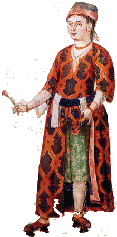| |

|
|

 |
2
OF 2 |
|
 The
dresses called üçetek (having a three-panelled skirt) and dörtetek
(having a four-panelled skirt) make their appearance in the early
19th century. Another costume consisting of baggy shalwars, a short,
tight~fitting jacket embroidered with silver thread, and a sash
with embroidered ends bound at the waist was as elegant as it was
comfortable to wear. Blouses were made of seersucker or silk and
had cuffs and collars trimmed with lace. A type of dress called
bindalli made from velvet or satin and heavily embroidered with
elaborate patterns in silver and gold braid were indispensable attire
for special occasions such as bridal henna-parties. The
dresses called üçetek (having a three-panelled skirt) and dörtetek
(having a four-panelled skirt) make their appearance in the early
19th century. Another costume consisting of baggy shalwars, a short,
tight~fitting jacket embroidered with silver thread, and a sash
with embroidered ends bound at the waist was as elegant as it was
comfortable to wear. Blouses were made of seersucker or silk and
had cuffs and collars trimmed with lace. A type of dress called
bindalli made from velvet or satin and heavily embroidered with
elaborate patterns in silver and gold braid were indispensable attire
for special occasions such as bridal henna-parties.
 One
result of steadily increasing European influence on the Ottoman
Empire was the occasional use of imported European fabrics in the
making of traditional woman's garments beginning in the 18th century.
During the 19th century, such traditional garments as the üçetek
and shalwar are cast aside in favor of costumes influenced by Parisian
fashions. Traditional dresses are replaced by close-fitting corseted
garments, blouses with long, full sleeves, and long, flounced skirts.
Such attire was naturally accompanied by accessories such as silk
stockings, fans, gloves, and parasols. The most important garment
in any woman's life is her wedding-dress. During every period, One
result of steadily increasing European influence on the Ottoman
Empire was the occasional use of imported European fabrics in the
making of traditional woman's garments beginning in the 18th century.
During the 19th century, such traditional garments as the üçetek
and shalwar are cast aside in favor of costumes influenced by Parisian
fashions. Traditional dresses are replaced by close-fitting corseted
garments, blouses with long, full sleeves, and long, flounced skirts.
Such attire was naturally accompanied by accessories such as silk
stockings, fans, gloves, and parasols. The most important garment
in any woman's life is her wedding-dress. During every period,  wedding-dresses
have been made using the most expensive fabrics available according
to the prevailing fashion and style. Until fairly late in the 19th
century, Ottoman brides dressed in lively colors (red was a particular
favorite) at their weddings. The bridal veil was also made of red
gauze well into the 19th century and was embroidered with silver
and gold braid. European fashions however begin to weigh heavily
in the design of Ottoman bridal costumes from about the 1870's onward.
While the fabrics are silk, the colors tend to be pastel pinks,
blues, and creams. The gowns are made in two parts and have a train
while the traditional silver and gold braid embellishments are augmented
with lace, pearls, and sequins. During this period, bridal gowns
were sometimes worn beneath a matching fur-lined kaftan.In 1898,
Princess Naime, daughter of Abdülhamid II, wore a pure-white bridal
gown at her wedding. The fashion of the bride's wearing white thus
introduced by the court was to influence the rest of Turkish society
in the following century. wedding-dresses
have been made using the most expensive fabrics available according
to the prevailing fashion and style. Until fairly late in the 19th
century, Ottoman brides dressed in lively colors (red was a particular
favorite) at their weddings. The bridal veil was also made of red
gauze well into the 19th century and was embroidered with silver
and gold braid. European fashions however begin to weigh heavily
in the design of Ottoman bridal costumes from about the 1870's onward.
While the fabrics are silk, the colors tend to be pastel pinks,
blues, and creams. The gowns are made in two parts and have a train
while the traditional silver and gold braid embellishments are augmented
with lace, pearls, and sequins. During this period, bridal gowns
were sometimes worn beneath a matching fur-lined kaftan.In 1898,
Princess Naime, daughter of Abdülhamid II, wore a pure-white bridal
gown at her wedding. The fashion of the bride's wearing white thus
introduced by the court was to influence the rest of Turkish society
in the following century.
 |
2
OF 2 |
|
|
|


